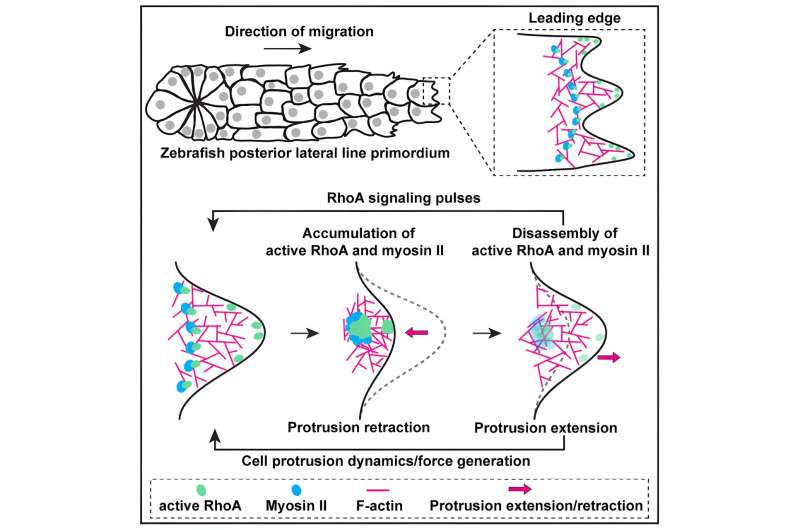This article has been reviewed according to Science X's editorial process and policies. Editors have highlighted the following attributes while ensuring the content's credibility:
fact-checked
peer-reviewed publication
trusted source
proofread
Cells found to move differently in groups than they do when alone

A protein that helps generate the force needed for single cells to move works differently in cells moving in groups, a new study shows.
Cells push and pull on each other and surrounding tissue to move as they form organs in an embryo, heal wounds, track down invading bacteria, and become cancerous and spread.
Led by researchers at NYU Grossman School of Medicine, the new study examined how forces are generated by a group of 140 cells called the primordium that adhere to each other as they move in zebrafish embryos. Zebrafish are a major model in the study of development because they are transparent and share cellular mechanisms with humans.
Published in Current Biology, the new work reveals how the cells in the primordium use a protein called RhoA to trigger forces that move the group into place in the developing embryo. To move, cells push out part of themselves called protrusions, use the protrusions to hold on to nearby tissues, and then haul them back in to pull forward, like casting out and hauling in an anchor.
"This finding surprised us because we had no reason to suspect that the RhoA machinery required to move groups of cells would be different from that used by single cells," said senior study author Holger Knaut, Ph.D., associate professor in the Department of Cell Biology at NYU Langone Health.
Past studies have shown that single cells move forward in part by activating RhoA at their back ends. Active RhoA turns on the motor protein non-muscle myosin II, which causes the back ends of the cells to constrict and let go of the surface they are moving along.
The current study found that the cells in the primordium instead activate RhoA in pulses in the front of the cells, where it does two jobs. At the front tip of the cell, RhoA grows the cell skeleton, called the actin meshwork, outward, forming protrusions that grip the surface.
At the base of protrusions, RhoA triggers non-muscle myosin II to pull on the actin meshwork and haul in the protrusions. The pulling by myosin II makes the actin flow toward the center and back of the cells, pushing the cell group forward the way a banana slug moves along the ground, but at a different size scale.
"Our findings suggest that RhoA-induced actin flow on the basal sides of cells constitutes the motor that pulls the primordium forward, a scenario that likely underlies the movement of many cell groups," added Dr. Knaut.
"The machinery suggests that the movement of single cells and groups of cells is similar but that RhoA contributes to that machinery differently in each case. Within moving cell groups, RhoA generates actin flow directed toward the rear to propel the group forward."
Dr. Knaut notes that a better understanding of the mechanisms by which cell groups move has the potential to be useful in stopping the spread of cancer, perhaps by guiding the design of treatments that block the action of proteins noted in the study.
More information: Michael Cammer et al, Pulses of RhoA Signaling Stimulate Actin Polymerization and Flow in Protrusions to Drive Collective Cell Migration, Current Biology (2023). DOI: 10.1016/j.cub.2023.11.044. www.cell.com/current-biology/f … 0960-9822(23)01594-4
Journal information: Current Biology
Provided by NYU Langone Health





















